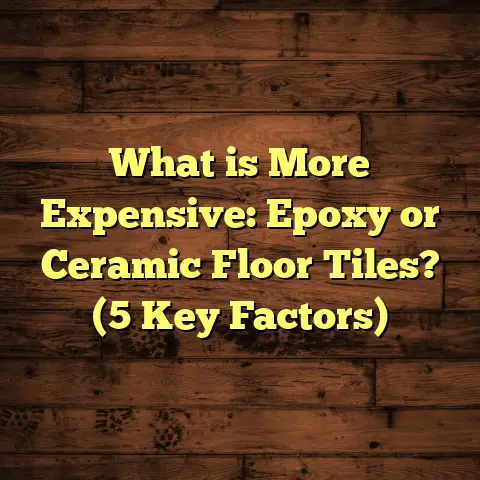What is Oak Flooring? (5 Reasons It’s the Best Choice for Homes)
Luxury in a home often starts from the ground up. The flooring you choose sets the tone for the entire space—whether it feels warm and inviting or cold and sterile. Over the years, I’ve worked on countless projects where oak flooring became the centerpiece of that luxurious vibe homeowners wanted. The beauty, durability, and timeless appeal of oak make it a favorite, not just for me as a contractor but for many who want their homes to feel special.
I want to walk you through everything I’ve learned about oak flooring: what it is, why it’s so popular, the upsides and challenges I’ve faced installing it, and how you can make the best choice for your home. Along the way, I’ll share personal stories and data-backed insights to help you get a clear picture.
What is Oak Flooring?
When people ask me, “What exactly is oak flooring?” I tell them it’s a type of hardwood flooring made from oak trees. Oak is one of the most common and trusted hardwood species used in flooring around the world. But there’s more to it than that simple definition.
Oak trees fall mainly into two categories used for flooring: red oak and white oak. Red oak has a warmer tone with pinkish hues, while white oak leans more toward greyish-brown shades. Both have distinct grain patterns that give them character.
The wood is harvested, cut into planks, then kiln-dried and milled to prepare it for flooring. These planks can be solid hardwood—meaning solid oak throughout—or engineered hardwood, where a top layer of oak is glued over plywood layers for added stability.
One thing that makes oak stand out is its hardness. On the Janka hardness scale (which measures resistance to denting and wear), red oak scores about 1290, and white oak scores slightly higher at 1360. For context, maple scores 1450, and pine is much softer at 420. This means oak is tough enough to handle daily life’s bumps without losing its charm.
The grain of oak is also distinct: bold and open with visible rays and flecks called medullary rays, which create a beautiful texture unique to oak. This natural patterning adds depth that synthetic floors can’t match.
Oak can be finished in many ways—natural clear coats to highlight its grain, stains to change its color, or distressed finishes for a rustic look. The versatility is one reason I often recommend oak to clients with different styles.
Why Oak Flooring Shines in Homes
1. Timeless Appearance That Grows on You
I once had a client who was worried oak might look “old-fashioned” in their modern home. But after installation, they were amazed at how the warm tones softened the space while still feeling fresh. Oak’s natural color palette ranges from pale honey to deep reddish browns, making it adaptable.
What’s fascinating is that oak ages like fine wine. Over time, exposure to light and air causes the wood to develop a patina—a subtle change in color that adds character. I’ve seen floors installed 20 years ago still look stunning because of this aging process.
If you like variety in texture and color, oak’s wide grain patterns provide visual interest without overwhelming a room. Unlike some tightly grained woods that feel cold or artificial, oak feels organic and welcoming.
2. Built to Last – Durability You Can Count On
I’ve installed oak floors in homes with active kids, dogs, and heavy foot traffic where durability was key. Oak’s hardness means it resists dents better than softer woods like pine or fir.
Data from the National Wood Flooring Association (NWFA) shows that hardwood floors can last between 30 to 100 years if cared for well—and oak is on the higher end due to its density.
One memorable project was a family home with three energetic children running around daily. After five years, the floors still looked fantastic with only minor surface scratches that easily buffed out.
This durability also means fewer replacements or repairs over time—saving money in the long run despite a higher initial price tag.
3. Versatility in Design Options
When clients come to me unsure about their design style, I always point out that oak flooring offers flexibility like few other materials.
Want a matte finish? Oak looks great with subtle sheen that hides imperfections. Prefer a glossy shine? Oak can be polished to reflect light beautifully.
I’ve experimented with various stains from natural blondes to smoky grays and even black finishes on oak planks—and each option creates a completely different mood.
The plank width also influences style. Narrow planks give traditional character; wider planks feel modern or rustic depending on finish.
4. Improves Home Value
If you’re planning ahead for resale value, hardwood floors including oak are a smart choice.
A 2020 study by the National Association of Realtors found homes with hardwood floors sold 5-10% faster and fetched higher prices.
Buyers associate hardwood floors with quality construction and good upkeep. It sends a message that the home has been cared for properly.
During my projects, I often hear clients share how potential buyers commented positively on their oak floors during showings—sometimes even influencing offers.
5. Easy Maintenance with Proper Care
People sometimes worry about wood floors being high-maintenance, but I tell them oak is fairly straightforward if you follow basic care routines.
Sweeping or vacuuming regularly prevents dirt from scratching surfaces. Mopping occasionally with wood-safe cleaners keeps floors looking fresh.
One homeowner told me they installed oak flooring over ten years ago and only refinished once thanks to consistent cleaning and avoiding excess moisture exposure.
Another tip—I recommend placing protective pads under furniture legs to prevent dents when moving pieces around.
Challenges I’ve Encountered with Oak Flooring
No product is without its hurdles. Here are some challenges I’ve faced working with oak:
Moisture Sensitivity
Because oak is natural wood, it reacts to humidity by expanding or contracting. This can cause gaps or cupping if moisture isn’t controlled properly during installation and afterward.
For example, I once installed an oak floor in a basement renovation without enough moisture barrier underlayment. After rainy seasons, some boards warped slightly. Fixing that meant removing damaged sections and improving moisture controls—expensive but necessary.
If you live in humid climates or plan to install below ground level, make sure your installer uses good moisture barriers and acclimates the wood properly before installation.
Cost Considerations
Oak flooring can be pricey upfront compared to laminate or vinyl alternatives.
Pricing depends on factors like plank thickness, finish type, installation complexity, and geographic labor rates.
I use FloorTally during project planning—it helps me quickly estimate costs by factoring material prices, labor rates in my area, waste percentages (usually around 5-10%), and other variables. This way clients get realistic budgets early on without surprises later.
While initial costs may seem high, keep in mind longevity often offsets these expenses over time.
Installation Complexity
Oak floors require skilled installation techniques:
- Subfloor preparation: must be level and dry.
- Acclimation: wood needs time (typically 48-72 hours) indoors before installation.
- Proper nailing/glue methods: depending on solid or engineered type.
- Expansion gaps: must be left around edges for wood movement.
Early in my career, I underestimated how critical each step was—leading to squeaks or uneven boards later on.
Now I always emphasize quality installation over speed to ensure long-lasting results.
Scratches & Surface Wear
Despite its hardness, oak isn’t scratch-proof. Pets’ claws or dragging furniture can leave marks over time.
I advise clients on protective measures like area rugs in high-traffic zones and regular refinishing schedules (every 7-10 years depending on use).
Personal Stories & Unique Insights
Over two decades of installing floors in diverse homes—from cozy cottages to luxury mansions—I’ve seen firsthand how oak makes a difference beyond aesthetics.
One story sticks out: A couple renovating their century-old farmhouse wanted floors “that felt historic but lasted modern life.” We chose white oak planks with wire brushing (a technique that adds texture) and a matte finish. The result preserved the home’s heritage while standing up to daily wear from kids and pets.
Another memorable project involved a city loft where owners wanted something warm yet sleek to complement industrial décor. We stained red oak with a gray wash finish; guests often complimented how the floors anchored the space’s edgy vibe without feeling cold or sterile.
From these experiences, I realize oak’s ability to adapt both visually and functionally makes it special.
Deep Dive: Installation Techniques for Oak Flooring
Understanding installation helps you appreciate why costs vary and why professional expertise matters.
Solid vs Engineered Oak Flooring
- Solid Oak: Made from single pieces of wood about 3/4 inch thick.
- Engineered Oak: Thin layer of real oak bonded over plywood layers for better stability against humidity changes.
Solid is great for above-ground areas and can be sanded/refinished multiple times over its life. Engineered works well in basements or places prone to moisture because it’s less likely to warp.
Nail-Down vs Floating Installation
- Nail-down: Common for solid hardwood; nails secure planks directly onto wooden subfloor.
- Floating: Planks click together over underlayment without nails; typical for engineered wood or DIY projects.
Each method has pros & cons regarding cost, durability, sound insulation, and ease of repair.
Preparing Your Subfloor
Before laying down anything:
- Subfloor must be clean, dry (moisture below 12%), level within 3/16 inch over 10 feet.
- Moisture barriers like polyethylene sheets or specialized underlayment help protect wood from humidity.
Skipping these steps risks costly problems later like cupping or buckling boards.
Acclimation Process
Wood should sit inside your home’s environment for at least 48 hours before installation to adjust moisture content—this reduces expansion/contraction surprises after installation.
Finishing Touches
After installation:
- Fill nail holes if necessary.
- Apply sealants or polyurethane coats for protection.
- Buff floors for smoothness and shine according to desired finish type.
Maintenance Tips That Keep Oak Floors Looking New
Keeping your floors pristine doesn’t have to be hard:
- Sweep/vacuum regularly using soft-bristle attachments.
- Avoid wet mopping; instead use damp cloths or recommended wood cleaners.
- Use furniture pads under heavy items.
- Keep pet nails trimmed.
- Place rugs at entrances to catch grit.
- Schedule refinishing every 7-10 years depending on wear level.
- Clean spills immediately to prevent stains or warping.
Comparing Oak Flooring with Other Popular Flooring Options
Let me break down how oak stacks up against alternatives:
| Floor Type | Durability | Maintenance | Cost | Appearance |
|---|---|---|---|---|
| Oak Hardwood | High | Moderate | Moderate-High | Natural grain & warmth |
| Laminate | Moderate | Low | Low | Mimics wood but less authentic |
| Vinyl Plank | Moderate | Low | Low | Wide style range |
| Carpet | Low | High | Low | Soft but stains easily |
| Tile | Very High | Low | Moderate | Cool & durable but cold |
Oak offers unmatched natural beauty combined with toughness—something synthetic options struggle to fully replicate.
Cost Breakdown: What You Can Expect When Installing Oak Floors
Cost varies by region but here’s a rough breakdown from my experience:
- Material cost: $5-$15 per sq ft depending on grade (clear grade costs more).
- Installation labor: $3-$8 per sq ft based on difficulty.
- Additional costs: removing old flooring ($1-$3 per sq ft), subfloor prep ($1-$2 per sq ft), finishing ($1-$3 per sq ft).
A typical 1,000 sq ft oak floor project might range from $9,000 to $25,000 total.
Using tools like FloorTally helps me customize estimates based on local labor/material costs plus waste factors (usually an extra 5%-10% material ordered for cuts/spills). It saves time juggling multiple quotes and reduces surprises during budgeting conversations with clients.
Design Trends Involving Oak Flooring
I’m often asked what styles are hot right now with oak floors:
- Wide plank flooring: Wider boards create airy looks popular in modern rustic designs.
- Gray-stained finishes: Offer trendy neutral tones blending cool modernity with warmth.
- Hand-scraped/textured surfaces: Add tactile feel mimicking aged floors.
- Mixed-width planks: Combine different widths randomly for dynamic visual interest.
- Matte finishes: Preferred over high gloss for understated elegance and practicality (less visible dust/scratches).
Choosing your finish depends heavily on lifestyle; busy households might prefer matte or textured surfaces hiding wear better than shiny smooth ones.
Final Thoughts From My Flooring Journey
If you’re thinking about flooring options that combine beauty, strength, and long-term value, oak is hard to beat. I’ve seen how it transforms spaces—from ordinary rooms into luxurious living areas that stand up to daily life’s demands.
Have you thought about what kind of wear your floors will face? Or how much time you want to spend maintaining them? These questions help decide if oak fits your lifestyle perfectly.
If budget planning feels overwhelming at first glance, tools like FloorTally simplify decision-making by providing detailed cost breakdowns factoring your preferences and location specifics—something I rely on every time I start a new project.
At the end of the day, choosing oak means investing in something that grows more beautiful over time—a foundation you can literally walk on for decades. Floors tell stories—make yours one worth sharing!





